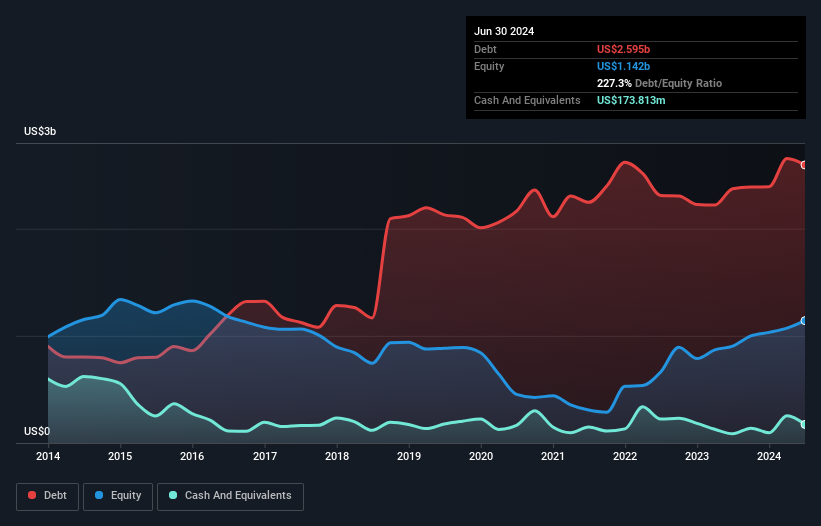Howard Marks put it nicely when he said that, rather than worrying about share price volatility, ‘The possibility of permanent loss is the risk I worry about… and every practical investor I know worries about.’ When we think about how risky a company is, we always like to look at its use of debt, since debt overload can lead to ruin. As with many other companies Kosmos Energy Ltd. (NYSE:KOS) makes use of debt. But the real question is whether this debt is making the company risky.
When Is Debt A Problem?
Generally speaking, debt only becomes a real problem when a company can’t easily pay it off, either by raising capital or with its own cash flow. If things get really bad, the lenders can take control of the business. However, a more common (but still painful) scenario is that it has to raise new equity capital at a low price, thus permanently diluting shareholders. Of course, debt can be an important tool in businesses, particularly capital heavy businesses. The first step when considering a company’s debt levels is to consider its cash and debt together.
See our latest analysis for Kosmos Energy
What Is Kosmos Energy’s Debt?
You can click the graphic below for the historical numbers, but it shows that as of June 2024 Kosmos Energy had US$2.60b of debt, an increase on US$2.37b, over one year. On the flip side, it has US$173.8m in cash leading to net debt of about US$2.42b.

How Strong Is Kosmos Energy’s Balance Sheet?
According to the last reported balance sheet, Kosmos Energy had liabilities of US$654.9m due within 12 months, and liabilities of US$3.59b due beyond 12 months. Offsetting this, it had US$173.8m in cash and US$113.1m in receivables that were due within 12 months. So its liabilities outweigh the sum of its cash and (near-term) receivables by US$3.96b.
This deficit casts a shadow over the US$1.99b company, like a colossus towering over mere mortals. So we’d watch its balance sheet closely, without a doubt. After all, Kosmos Energy would likely require a major re-capitalisation if it had to pay its creditors today.
We use two main ratios to inform us about debt levels relative to earnings. The first is net debt divided by earnings before interest, tax, depreciation, and amortization (EBITDA), while the second is how many times its earnings before interest and tax (EBIT) covers its interest expense (or its interest cover, for short). This way, we consider both the absolute quantum of the debt, as well as the interest rates paid on it.
Kosmos Energy’s net debt to EBITDA ratio of about 2.0 suggests only moderate use of debt. And its strong interest cover of 12.7 times, makes us even more comfortable. Importantly, Kosmos Energy grew its EBIT by 50% over the last twelve months, and that growth will make it easier to handle its debt. The balance sheet is clearly the area to focus on when you are analysing debt. But ultimately the future profitability of the business will decide if Kosmos Energy can strengthen its balance sheet over time. So if you’re focused on the future you can check out this free report showing analyst profit forecasts.
But our final consideration is also important, because a company cannot pay debt with paper profits; it needs cold hard cash. So the logical step is to look at the proportion of that EBIT that is matched by actual free cash flow. During the last three years, Kosmos Energy burned a lot of cash. While that may be a result of expenditure for growth, it does make the debt far more risky.
Our View
On the face of it, Kosmos Energy’s conversion of EBIT to free cash flow left us tentative about the stock, and its level of total liabilities was no more enticing than the one empty restaurant on the busiest night of the year. But at least it’s pretty decent at covering its interest expense with its EBIT; that’s encouraging. Once we consider all the factors above, together, it seems to us that Kosmos Energy’s debt is making it a bit risky. That’s not necessarily a bad thing, but we’d generally feel more comfortable with less leverage. When analysing debt levels, the balance sheet is the obvious place to start. But ultimately, every company can contain risks that exist outside of the balance sheet. We’ve identified 2 warning signs with Kosmos Energy , and understanding them should be part of your investment process.
When all is said and done, sometimes its easier to focus on companies that don’t even need debt. Readers can access a list of growth stocks with zero net debt 100% free, right now.
Valuation is complex, but we’re here to simplify it.
Discover if Kosmos Energy might be undervalued or overvalued with our detailed analysis, featuring fair value estimates, potential risks, dividends, insider trades, and its financial condition.
Have feedback on this article? Concerned about the content? Get in touch with us directly. Alternatively, email editorial-team (at) simplywallst.com.
This article by Simply Wall St is general in nature. We provide commentary based on historical data and analyst forecasts only using an unbiased methodology and our articles are not intended to be financial advice. It does not constitute a recommendation to buy or sell any stock, and does not take account of your objectives, or your financial situation. We aim to bring you long-term focused analysis driven by fundamental data. Note that our analysis may not factor in the latest price-sensitive company announcements or qualitative material. Simply Wall St has no position in any stocks mentioned.

